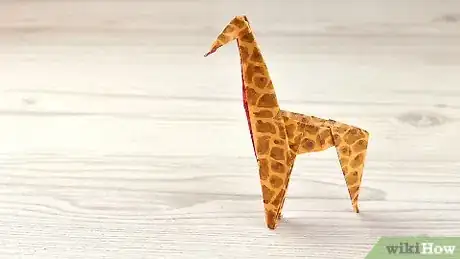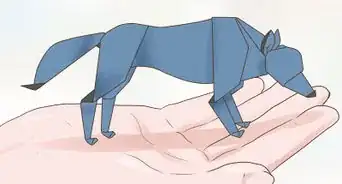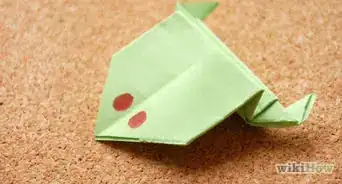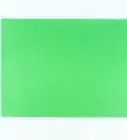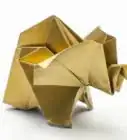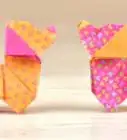This article was co-authored by wikiHow staff writer, Janice Tieperman. Janice is a professional and creative writer who has worked at wikiHow since 2019. With both a B.A. and M.A. in English from East Stroudsburg University, she has a passion for writing a wide variety of content for anyone and everyone. In her free time, you can find her working on a new crochet pattern, listening to true crime podcasts, or tackling a new creative writing project.
There are 20 references cited in this article, which can be found at the bottom of the page.
The wikiHow Video Team also followed the article's instructions and verified that they work.
This article has been viewed 67,758 times.
Learn more...
Origami giraffes are a fun gift for friends and family, or you can use them as a fun decoration. This particular pattern can be tricky, as it involves a lot of intricate folds and creases. Don’t be discouraged if it takes you a few tries to make this—after all, practice makes perfect!
Steps
Creating the Initial Folds
-
1Color in brown spots on some yellow origami paper to design the pattern. Take a brown marker and sketch out different shapes all over the colored side of your origami paper. Color in all the spots to create a realistic pattern for your origami giraffe.[1]
- Ideally, use origami paper that’s about 10 by 10 cm (3.9 by 3.9 in). However, any square-shaped piece of paper will work.[2]
-
2Fold and unfold the paper in half twice to make 2 creases. Lay the square piece of paper on your workspace, then fold the right and left edges together. Crease along the folded edge of the paper and unfold it again. To make the paper easier to work with, fold the paper from top to bottom to create another crease in your paper.[3]
- At this point, you’ll have 2 creases forming a “plus” sign on your origami paper.
Advertisement -
3Rotate the same sheet of paper so it looks like a diamond. Place your folded paper with the pattern side facing up. Turn the paper 45-degrees so it looks like a diamond, with the pointed corner facing upwards.[4]
- An origami giraffe requires a lot of folds, so you’ll need to adjust your paper a lot to make all the folds you need.
-
4Fold and unfold the paper in half twice to make 2 more creases. Crease the paper so the top and bottom corners are touching each other. Press and slide your finger along the line to create a definitive crease along your paper. Unfold the paper and then fold it half again, allowing the left and right corners to meet. Crease this edge and unfold the paper again so the colored side is facing up.[5]
- At this point, your paper should have a total of 4 creases.
-
5Pinch and press the paper into a small square. Push the center of the paper up with your finger so all the creases slope away at a downward angle. Fold the paper in half slightly, leaving the bottom of the paper open. Pinch both sides of the folded paper and push them towards the center. At this point, flatten the paper into a folded square.[6]
- The colored, patterned side of the paper will still be facing outwards.
-
6Fold the side corners of paper into the center. Take the left corner on top of the folded square and fold the bottom left section of paper into the center, vertical crease. Repeat this process with the right corner of the square. Crease along the edges of these folds so the paper holds its shape.[7]
- You’re only folding the top layer of paper, not the entire square.
- At this point, an unfolded triangle will be visible along the top of the square.
-
7Flip the square over and repeat this folding process. Turn your square over so the section you just folded is face-down. Do the same folding pattern that you did before, bringing the bottom right and left corners along the center the center crease. Press along the side creases to hold these folds in place.[8]
- At this point, both sides of the square will be folded. There will also be an unfolded triangle along the top of the back square.
Forming the Basic Giraffe Shape
-
1Fold the top triangular section of the paper downwards. Take the entire upper triangle and fold it down over the back side of the square. This will form a smaller triangle with the folded origami paper.[9]
- You’ll be folding all the paper layers over instead of just 1.
-
2Flip the paper over and lift up the folded section. Hold your paper triangle with the recently folded triangle facing down. Open the 2 folds on the front of the triangle, then lift the unfolded paper upwards. This will form a large diamond shape within your origami paper.[10]
- This part can be a little tricky to get down at first. Don’t be discouraged if you don’t nail it right away!
-
3Press the paper into a kite shape. Refold the bottom sections of paper into a triangle shape along the bottom half of your origami paper. Make the top section of the diamond a mirror image of the bottom by folding 2 smaller triangles into the center of the paper.[11]
- At this point, your paper will look like a kite, with 4 equal triangles of paper folded towards the center.
-
4Do the same flip, fold, and press on the other side. Flip your paper over and lift up the small triangle that you just folded over. Unfold the larger triangles along the bottom half of the diamond, then unfold the paper into a larger diamond as you did before. Press the bottom half of the diamond into 2 identical triangles, and repeat the same folds with the top, unfolded section of paper. When you’re done, both sides of the origami will look identical.[12]
- This section will also look like a kite.
-
5Hold the paper structure upright and fold it in half. Pinch the top half of each diamond on both sides of your origami paper. Tug on both sections to expand the paper, creating a larger structure. Pull and stretch out the folded origami until the top, colored section of paper is completely flat. Fold the upright paper vertically so 4 even points of paper stick out in each direction.[13]
- You’ll be folding the paper backwards instead of forwards as you do this.
-
6Fold the 2 side points upward to create a paper hat shape. Pinch along both sides of the front and back points of your origami paper. Check that the triangles match each other and create an even fold. Always crease along the bottom edge of your fold so the paper holds its shape.[14]
- At this point, your origami giraffe will kind of resemble a paper hat.
Fine-tuning the Features
-
1Flip the paper and push the left section of paper upwards. Shift your folded origami paper so the folded points are now facing downwards. Hold the central part of the paper with 1 hand, then use your opposite to push the left point upwards. When pushed forward, the paper will become a regular folded triangle, similar to a kite shape.[15]
- This will serve as the neck and head of your giraffe.
-
2Fold the front section of paper backward to form the neck and front legs. Press along the left and right sections of the neck, creasing them in place so they fold around the giraffe’s body.
-
3Crease the back section of paper downwards to form the back legs. Create an initial fold for the back legs before you actually fold them into place. Take the right, folded point of paper and fold it downwards, creating a basic leg shape. Press along the edge of the fold to form an exact crease.[16]
- This isn’t the permanent position of the back legs—the crease will just help you assemble the giraffe.
- The point of the front and back legs need to be the same length. If your back leg is too long or too short, you may need to refold.
-
4Unfold the back legs and crease them into place. Lift the folded paper so it’s back in a straight line, then turn the paper inside out. Fold and crease 1 triangle along the left side of the giraffe, and the other triangle along the right side of the giraffe. Check that both of these triangles are mirror images of 1 another.[17]
- The back legs should still be in line with the front legs.
-
5Fold and crease the upper section of the paper neck to form the head. Take a small, 1 cm (0.39 in) section or so from the top, upper point of the giraffe’s neck and fold it forwards. Crease along the fold so you have a distinct idea of where the giraffe’s head will go. As you did with the back legs, unfold the section of paper making up the head and crease 1 triangle along the left and right sides of the giraffe’s neck.[18]
-
6Crease and fold both halves of the neck to make it thin and rectangular. Unfold the giraffe’s neck slightly, which should resemble a large, folded triangle. Fold and crease in the tipped edge of the neck, giving the giraffe’s neck a straight edge and rectangular shape. Repeat this on the other side so the giraffe’s neck looks straight and sleek.[19]
-
7Repeat this folding and creasing section along the giraffe’s back. Open up the folds on top of the giraffe's back and fold a small, triangular section of paper inwards on each side. Crease along the edges so the giraffe’s back looks straight instead of humped.[20]
- You can display your giraffe by balancing it on its paper legs.
Community Q&A
Did you know you can get answers researched by wikiHow Staff?
Unlock staff-researched answers by supporting wikiHow
-
QuestionWhy doesn't it look like a giraffe?
 wikiHow Staff EditorThis answer was written by one of our trained team of researchers who validated it for accuracy and comprehensiveness.
wikiHow Staff EditorThis answer was written by one of our trained team of researchers who validated it for accuracy and comprehensiveness.
Staff Answer wikiHow Staff EditorStaff Answer
wikiHow Staff EditorStaff Answer -
QuestionWhy does the giraffe have a short neck when they are known for the tremendous length of that part of their bodies?
 wikiHow Staff EditorThis answer was written by one of our trained team of researchers who validated it for accuracy and comprehensiveness.
wikiHow Staff EditorThis answer was written by one of our trained team of researchers who validated it for accuracy and comprehensiveness.
Staff Answer wikiHow Staff EditorStaff Answer
wikiHow Staff EditorStaff Answer -
QuestionDoesn't a giraffe have a long neck instead of long legs?
 Community AnswerGiraffes have both long legs and long necks.
Community AnswerGiraffes have both long legs and long necks.
Things You’ll Need
- Square-shaped yellow origami paper, ideally 10 by 10 cm (3.9 by 3.9 in)
- Markers (optional)
References
- ↑ https://m.youtube.com/watch?vl=en&v=WmMsU0Qjp8Y&t=0m38s
- ↑ https://m.youtube.com/watch?v=GEoj8TLSVO0&t=0m3s
- ↑ https://m.youtube.com/watch?vl=en&v=WmMsU0Qjp8Y&t=1m12s
- ↑ https://m.youtube.com/watch?v=GEoj8TLSVO0&t=0m34s
- ↑ https://m.youtube.com/watch?v=4HQM_ceXfMs&t=0m52s
- ↑ https://m.youtube.com/watch?v=4HQM_ceXfMs&t=1m10s
- ↑ https://m.youtube.com/watch?v=4HQM_ceXfMs&t=1m37s
- ↑ https://m.youtube.com/watch?v=GEoj8TLSVO0&t=1m40s
- ↑ https://m.youtube.com/watch?v=4HQM_ceXfMs&t=2m10s
- ↑ https://m.youtube.com/watch?v=4HQM_ceXfMs&t=2m18s
- ↑ https://m.youtube.com/watch?v=GEoj8TLSVO0&t=2m17s
- ↑ https://origami.me/giraffe-2/
- ↑ https://m.youtube.com/watch?v=4HQM_ceXfMs&t=3m10s
- ↑ https://m.youtube.com/watch?v=4HQM_ceXfMs&t=3m35s
- ↑ https://m.youtube.com/watch?v=4HQM_ceXfMs&t=3m50s
- ↑ https://m.youtube.com/watch?v=4HQM_ceXfMs&t=4m14s
- ↑ https://m.youtube.com/watch?v=4HQM_ceXfMs&t=4m29s
- ↑ https://m.youtube.com/watch?v=4HQM_ceXfMs&t=4m50s
- ↑ https://m.youtube.com/watch?v=4HQM_ceXfMs&t=5m10s
- ↑ https://m.youtube.com/watch?v=4HQM_ceXfMs&t=5m50s
About This Article
To make an origami giraffe, start with a square, yellow piece of origami paper. Draw spots on the paper with brown marker to make a giraffe pattern. Then, fold the paper in half both ways, unfolding after each fold. Now fold the paper in half diagonally both ways, unfolding after each fold. Flatten the paper into a small square along the creases you made, rotating the square so it looks like a diamond. Fold the right and left corners into the center vertical crease, then flip the square over and do the same thing on the other side. Next, fold down the triangle at the top of the paper and flip the paper over. Open the 2 folds and lift up the top layer of the paper, pressing down on the existing creases to make a kite shape. Flip the paper over and repeat on the other side. Pull the flaps on each kite shape away from each other to expand the paper, then fold it in half lengthwise. Fold up the two points on the side and rotate the paper so they’re pointing down. Fold the left point up and into the paper so it’s now pointing up. Then, fold the flaps on the left side of the paper to the right. Fold the right point to the left so it’s pointing down, then reverse fold the point to make the back legs. Fold down the tip of the top point and reverse fold it to make the head. Next, fold in the points on the neck to make it thin and rectangular. Finally, open up the folds on the giraffe’s back and fold the point on the back inward to make the back straight. For step-by-step instructions with videos, check out the full article!

